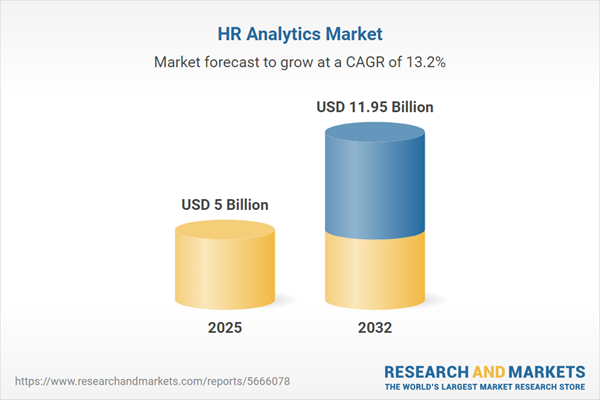Speak directly to the analyst to clarify any post sales queries you may have.
HR analytics is transforming the way organizations manage talent, drive workforce productivity, and make strategic business decisions. As the adoption of advanced analytics and cloud-based HR technology accelerates, market momentum is being shaped by evolving workforce dynamics and enterprise demand for actionable insights.
HR Analytics Market Snapshot
The HR analytics market grew from USD 4.42 billion in 2024 to USD 5 billion in 2025, and is projected to grow at a CAGR of 13.23% through 2032, reaching USD 11.95 billion. This expansion underscores increasing reliance on workforce analytics to enable effective talent management, performance improvement, and competitive agility. With rising investments in AI, machine learning, and cloud-first platforms, organizations are leveraging HR analytics to gain a strategic edge in an environment defined by rapid business transformation.
Scope & Segmentation
- Component: Services (consulting, integration, support) and Software (learning management, performance management, talent management, workforce analytics including descriptive, predictive, and prescriptive features)
- Deployment Model: Cloud and On-premises solutions serving a range of operational and compliance needs
- Enterprise Size: Large enterprises; Small and medium enterprises
- Verticals: BFSI with banking (commercial and investment), insurance (life and non-life); Healthcare (clinics, hospitals); IT and Telecom (IT and telecom services); Manufacturing (automotive, electronics); Retail (brick-and-mortar, e-commerce)
- Regions: Americas (North America: United States, Canada, Mexico; Latin America: Brazil, Argentina, Chile, Colombia, Peru); Europe, Middle East & Africa (Europe: United Kingdom, Germany, France, Russia, Italy, Spain, Netherlands, Sweden, Poland, Switzerland; Middle East: United Arab Emirates, Saudi Arabia, Qatar, Turkey, Israel; Africa: South Africa, Nigeria, Egypt, Kenya); Asia-Pacific (China, India, Japan, Australia, South Korea, Indonesia, Thailand, Malaysia, Singapore, Taiwan)
- Leading Companies: Workday, SAP, Oracle, ADP, Ceridian, UKG, IBM, Infor, Cornerstone OnDemand, Visier
Key Takeaways for Senior Decision Makers
- HR analytics adoption is being driven by the convergence of artificial intelligence, advanced data visualization, and cloud architectures, which enhance both predictive capabilities and workforce agility.
- Workforce shifts such as remote and gig arrangements require organizations to manage data from diverse sources, heightening the importance of effective governance and compliance measures.
- Enterprise needs vary: large businesses favor platforms that consolidate complex data, while SMEs seek cost-effective, streamlined solutions with rapid implementation.
- Industry-specific demands mean banking, insurance, healthcare, manufacturing, IT, and retail value tailored analytics for recruitment, performance, training, and workforce planning.
- Regional differences in data protection and digital adoption—such as GDPR compliance in Europe, cloud maturity in the Americas, and mobile-driven growth in Asia-Pacific—are shaping vendor strategies.
Tariff Impact on HR Analytics Adoption
- US tariff policies have increased costs and caused delays for organizations using imported hardware, especially for on-premises HR analytics deployments.
- Service providers are shifting to local suppliers and prioritizing cloud-based models, reducing capital investment and supply chain risk.
- Global employers confront added complexities in cross-border talent mobility and data security, requiring robust encryption and jurisdictional risk assessments within HR analytics solutions.
Methodology & Data Sources
This report employs a multimethod research approach: quantitative datasets are combined with interviews from senior HR leaders and technology vendors. Secondary research includes company materials, public disclosures, and industry publications. The methodology ensures integrity through rigorous data cleansing, triangulation for consistency, and statistical analysis for trend validation.
Why This Report Matters for Leadership
- Supports evidence-based decision making by offering granular analysis on components, deployment models, enterprise needs, and industry verticals.
- Delivers actionable insights on how to optimize HR technology strategies in response to regulatory changes and evolving workforce structures.
- Enables benchmarking vendor offerings and innovation pathways to drive strategic investments and future-proof organizational capabilities.
Conclusion
HR analytics is a critical lever for enabling resilient, agile, and informed workforce management. By understanding shifting dynamics, leaders can align talent strategy with long-term business goals and navigate the path to sustainable competitive advantage.
Additional Product Information:
- Purchase of this report includes 1 year online access with quarterly updates.
- This report can be updated on request. Please contact our Customer Experience team using the Ask a Question widget on our website.
Table of Contents
3. Executive Summary
4. Market Overview
7. Cumulative Impact of Artificial Intelligence 2025
Companies Mentioned
The companies profiled in this HR Analytics market report include:- Workday, Inc.
- SAP SE
- Oracle Corporation
- ADP, LLC
- Ceridian HCM, Inc.
- UKG Inc.
- IBM Corporation
- Infor, Inc.
- Cornerstone OnDemand, Inc.
- Visier, Inc.
Table Information
| Report Attribute | Details |
|---|---|
| No. of Pages | 194 |
| Published | October 2025 |
| Forecast Period | 2025 - 2032 |
| Estimated Market Value ( USD | $ 5 Billion |
| Forecasted Market Value ( USD | $ 11.95 Billion |
| Compound Annual Growth Rate | 13.2% |
| Regions Covered | Global |
| No. of Companies Mentioned | 11 |









